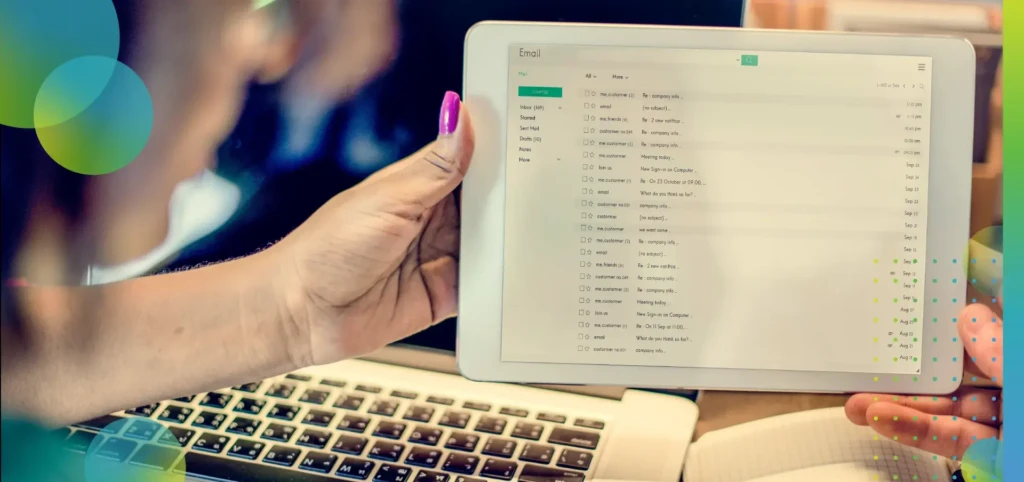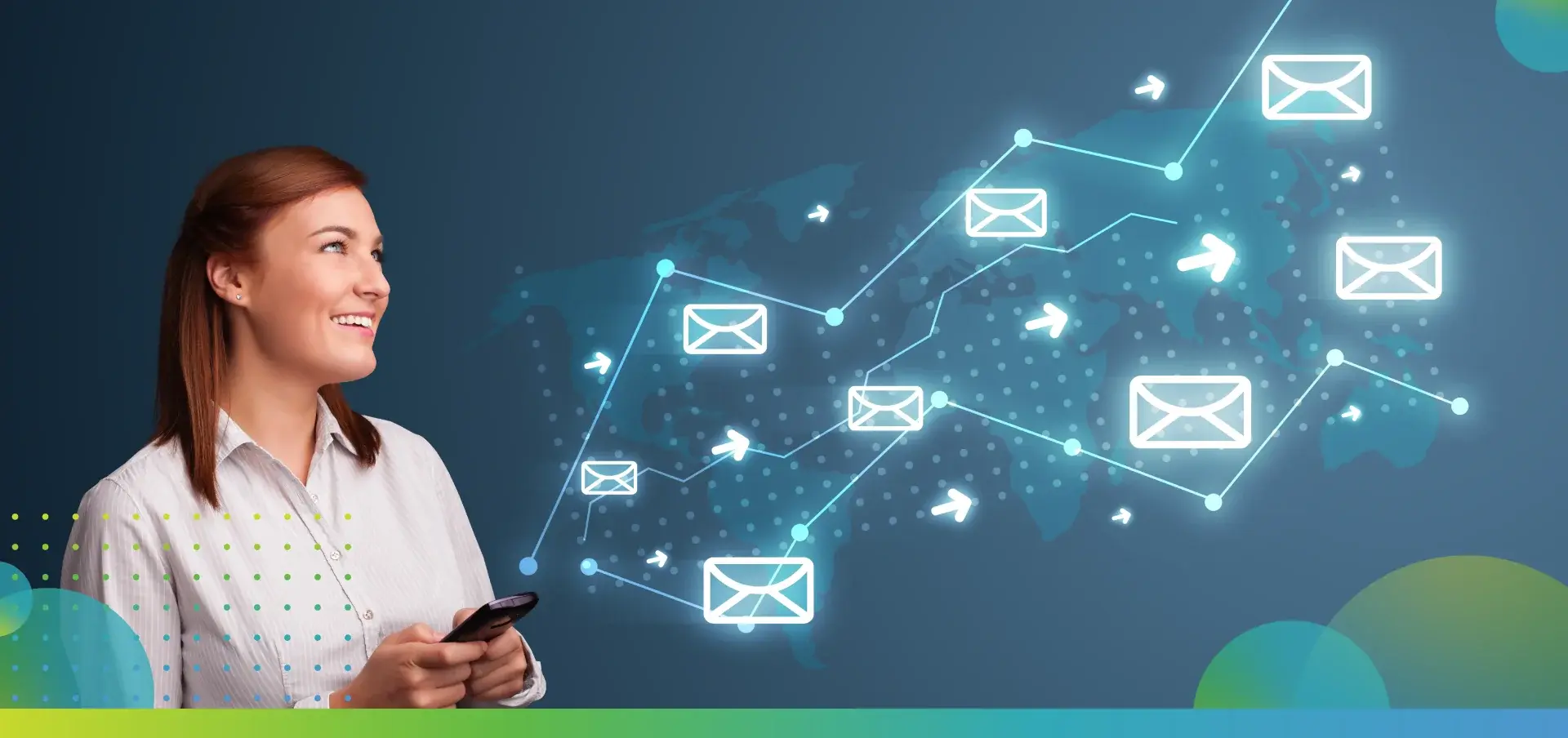Email marketing continues to deliver exceptional returns in 2025, with businesses earning $10 to $36 for every $1 spent—a staggering 1,000-3,600% Return on Investment (ROI).
For partners at Hostopia working with small and medium-sized businesses (SMBs), this presents a substantial possibility to help clients build sustainable growth through strategic email marketing lead generation.
As a white-label platform provider offering email marketing tools to telecommunication providers, cable companies, and domain registrars, Hostopia empowers partners to educate their SMB clients on proven tactics that drive real results.
This guide equips you with the knowledge to confidently teach clients how to capture leads, nurture relationships, and convert prospects into loyal customers through email marketing.
- Breaking Down Email Leads & Lead Generation
- Why Email Marketing Is Still a Driver for Sales
- Building Email Lists: A Foundational Element for Existing Subscribers
- Segmentation & Personalization for More Leads
- Email Automation: Tapping Into the Exciting World
- Campaign Types to Keep in Mind
- Deliverability Best Practices for Guaranteed Success
- Action Plan: The ABCs of Email Marketing

Breaking Down Email Leads & Lead Generation
Email leads are prospective customers who have willingly shared their email address with your business, signaling genuine interest and giving permission for ongoing communication. These individuals may sign up to receive a newsletter, access a valuable resource, or await updates on a new product launch.
Unlike cold contacts, email leads are “warm” prospects—this elevated status means they are far more likely to become paying customers thanks to their proactive engagement.
Email lead generation describes the process behind acquiring these warm prospects. It’s more than collecting email addresses—it’s about attracting and converting website visitors or audience members with compelling opt-in incentives, capturing their details through forms or landing pages, and then nurturing them through targeted email campaigns until they are ready to purchase.
This approach centers the entire journey around adding value, offering resources, and building trust, ultimately guiding leads from initial contact to loyal customers.
When done right, email lead generation becomes a foundational growth engine for SMBs, allowing for scalable, measurable, and sustained business development.
Why Email Marketing Is Still a Driver for Sales
Despite the continued emergence of new marketing channels, email marketing remains highly effective today, with thousands of businesses depending on it.
Nearly 4.5 billion people use email worldwide, and 99% check their inbox at least once per day. Email marketing generates an average conversion rate of 2.8% for B2C brands and 2.4% for B2B businesses.
Automated emails drive 37% of all email-generated sales while accounting for just 2% of email volume. Welcome emails alone generate 320% more revenue compared to standard promotional campaigns. For SMB clients working with limited marketing budgets, email’s average ROI of $36-$40 per dollar spent far exceeds social media and pay-per-click advertising.
Perhaps most valuable, email represents an owned marketing channel. Unlike social media platforms, where algorithm changes devastate organic reach, businesses maintain direct control over their email lists and communications. This independence creates a foundation for sustainable, long-term customer relationships.

Building Email Lists: A Foundational Element for Existing Subscribers
The foundation of successful email marketing lead generation starts with building a quality email list. A smaller list of engaged subscribers will always outperform a massive list of disinterested contacts.
Lead Magnets That Convert
Lead magnets are valuable resources offered in exchange for email addresses. Top-performing lead magnet types for SMBs include:
- Discount codes: Offering 15-20% off first purchases converts exceptionally well for eCommerce and service-based businesses. Creating urgency with time-limited offers increases opt-in rates.
- Free trials and demos: Allowing prospects to experience products firsthand builds confidence and trust. This works particularly well for software, subscription services, and B2B offerings.
- Educational resources: Guides, checklists, templates, and how-to ebooks position businesses as helpful experts. These work across virtually all industries and provide lasting value.
- Exclusive content access: Offering early access to sales, members-only resources, or insider information creates a sense of privilege that drives sign-ups.
The key is ensuring lead magnets align with what prospects actually need. A landscaping company might offer a “Seasonal Garden Care Checklist,” while a marketing consultant could provide a “Social Media Content Calendar Template.” Specificity and relevance drive results.
Optimize Opt-In Forms & Placement
Keep opt-in forms simple by requesting only essential information—typically name and email address. Strategic placement matters tremendously.
Position opt-in forms in high-traffic areas: website headers or footers, within blog posts after valuable content, as exit-intent popups, and on dedicated landing pages. With 60% of emails opened on mobile devices, ensure all forms are fully responsive.
The value proposition must be crystal clear. Instead of generic “Subscribe to our newsletter” copy, use specific benefit-driven language: “Get weekly marketing tips delivered to your inbox.”

Segmentation & Personalization for More Leads
Once email lists grow, segmentation and personalization become critical for maximizing engagement and conversions.
Segmented campaigns generate 6x more transactions than non-segmented blasts, and personalized subject lines improve click-through rates by 0.29%—translating to 58 additional clicks per 20,000 recipients.
Key Segmentation Strategies
Help SMB clients implement these proven approaches:
- Demographics: Segment by age, location, industry, or company size.
- Behavioral: Track email engagement, website activity, and purchase history.
- Customer lifecycle: New subscribers need welcome sequences. Active customers might receive loyalty rewards. Inactive subscribers require re-engagement campaigns.
- Purchase history: Customers who bought specific categories can receive targeted recommendations and complementary product suggestions.
- Geographic: Location-based segmentation enables time-zone-appropriate sending, local event promotions, and region-specific offers.
Personalization Beyond First Names
True personalization goes much deeper than basic name insertion. Modern email platforms enable dynamic content blocks that change based on subscriber data.
A single email template can display different product recommendations, images, or offers depending on each recipient’s preferences or past behavior.
Behavioral triggers create highly relevant, timely messages. When a customer abandons a shopping cart, trigger an automated reminder within 1-3 hours. Send-time optimization uses data to deliver emails when each subscriber is most likely to engage.

Email Automation: Tapping Into the Exciting World
Email automation transforms lead generation from a time-intensive manual process into a scalable, efficient system that works 24/7.
Automated emails generate 320% more revenue than non-automated campaigns while requiring a fraction of the effort.
Essential Automated Workflows
Welcome Series: The welcome series is arguably the most important workflow. Structure a 5-email series over 7-14 days:
- Email 1 (immediate): Welcome and deliver promised lead magnet
- Email 2 (2-3 days): Share brand story and values
- Email 3 (2-3 days): Showcase best products and testimonials
- Email 4 (2-3 days): Offer exclusive subscriber discount
- Email 5 (3-5 days): Invite to communities and referral programs
Lead Nurture Sequences: Not every subscriber is ready to buy immediately. Deliver educational content over weeks or months, building trust and demonstrating expertise. A typical nurture sequence includes industry insights, how-to guides, case studies, and soft calls-to-action.
Abandoned Cart Recovery: For eCommerce SMBs, abandoned cart sequences are revenue gold mines. Configure triggers to send reminders 1-3 hours after abandonment, followed by additional emails at 24 and 72 hours. Include product images, clear calls-to-action, and customer reviews.
Partner Resource: Recommend affordable automation platforms like Mailchimp, Brevo, or MailerLite that offer robust features at SMB-friendly price points.
Campaign Types to Keep in Mind
Beyond automated workflows, SMB clients should implement several campaign types to engage their email lists and drive consistent conversions.
Newsletter Campaigns
Regular newsletters keep businesses top-of-mind while providing ongoing value. Balance educational content with promotional messaging—aim for approximately 90% valuable content and 10% promotional material. This ratio builds trust and maintains engagement while still driving business results.
Promotional Campaigns
Promotional campaigns drive immediate action through limited-time offers, seasonal events, product launches, or exclusive deals. Structure promotional emails with the value proposition front and center. Use single, focused calls-to-action.
Examples include flash sales, seasonal promotions, new product launches, and exclusive subscriber discounts.
Lead Nurture and Milestone Campaigns
Strategic nurture campaigns target specific segments with focused content series that guide prospects through decision-making. Milestone campaigns celebrate important dates—birthdays, customer anniversaries—strengthening relationships and demonstrating individual value.

Deliverability Best Practices for Guaranteed Success
Even compelling campaigns fail if they never reach subscribers’ inboxes. Email deliverability requires technical setup, list hygiene, and content best practices.
Technical Foundation & List Hygiene
Set up domain authentication (SPF, DKIM, DMARC records) to establish sender credibility. Use real reply-to addresses—never “no-reply@”. Maintain consistent sending patterns and gradually warm new domains.
Keep lists healthy by removing hard bounces immediately, monitoring engagement, using double opt-in, and never buying email lists. List quality directly impacts deliverability—unengaged contacts damage the sender’s reputation.
Content Best Practices
Include substantial text content alongside images. Avoid excessive spam trigger words like “free,” “guarantee,” or “limited time.” Use honest subject lines that accurately represent content. Include clear, functional unsubscribe links and preference centers. With 50% of users deleting non-mobile-friendly emails, responsive design is non-negotiable.
Metrics & Optimization
Data-driven optimization separates mediocre email programs from exceptional ones. Track these essential metrics:
Open Rate (35-42% average): Indicates subject line effectiveness and sender reputation.
Click-Through Rate (2-3.2% average): Indicates compelling content and clear calls-to-action.
Conversion Rate (2.4-2.8% average on B2B and B2C markets, respectively): The ultimate success metric. Automated flows achieve significantly higher rates.
Bounce Rate (keep below 2%): Indicates list quality problems.
Systematically A/B test email elements: subject lines, send times, calls-to-action, and content formats. Test one variable at a time with statistically significant sample sizes (minimum 1,000 recipients per variant).

Action Plan: The ABCs of Email Marketing
Help SMB clients implement email marketing systematically in three phases:
Phase 1: Foundation (Month 1)
Choose an email platform suitable for the business size and budget. Set up domain authentication. Create 2-3 lead magnets solving specific customer problems. Build opt-in forms with clear value propositions. Start list building through existing channels.
Phase 2: Automation Setup (Month 2)
Design a welcome email series introducing new subscribers. Create basic segmentation rules separating customers from prospects. Set up abandoned cart workflow for eCommerce businesses. Build a newsletter template establishing consistent branding.
Phase 3: Campaign Launch (Month 3 onwards)
Launch a regular newsletter on a consistent schedule. Test promotional campaigns around natural opportunities. Implement lead nurture sequences targeting unconverted prospects. Begin A/B testing key elements. Monitor and optimize using platform analytics.
Final Words
Email marketing lead generation delivers unmatched ROI for SMBs willing to invest time in building quality lists, creating valuable content, and nurturing relationships.
The $36-$40 return per $1 spent makes email one of the most profitable marketing channels available—especially for businesses with limited budgets.
Success doesn’t require perfection from day one. Encourage SMB clients to start with foundational elements like lead magnets and welcome series, then progressively layer in segmentation, personalization, and advanced automation as they gain experience.
As Hostopia partners, you play a crucial role in helping SMB clients navigate email marketing successfully. By teaching these proven strategies—list building, segmentation, automation, diverse campaign types, deliverability best practices, and data-driven optimization—you empower clients to build sustainable businesses with predictable customer acquisition.
Ready to help your SMB clients unlock email marketing’s full potential? For additional resources, training materials, and partner support, contact us at learnmore@hostopia.com. Together, we can help small businesses thrive through strategic email marketing lead generation.

